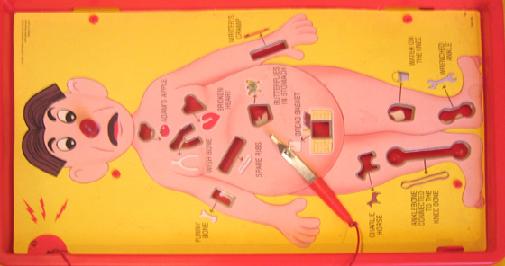Science Fiction
Dictionary
A B C D E F G H I J K L M N O P Q R S T U V W X Y Z
Doctor-Bots Play 'Operation'

Doctor-Bots constructed by University of British Columbia engineering students might be the forerunners of tomorrow's medical robots. Today, though, they are playing an over-sized version of "Operation," the Milton-Bradley game.
(Doctor-Bots play Operation video)
Second-year students work in teams to create prototypes of "surgical" robots. This year, fourteen teams put in 50-70 hour weeks (in addition to classes) to compete in the annual robot competition at their university.
The objective of their version of the Operation game is to remove the most metal body parts in two minutes, without removing the wrong eye and without bumping the sides of the "incisions." The robots are built from scratch and are operated autonomously - no remote controls.

(Original Milton Bradley Operation game board)
The robots maneuver around the oversized "Operation" game board, and then try to "operate" by removing different parts. As you can see in the above video, some teams are have created more successful robot "surgeons" than others.
The idea of a robot that can operate autonomously on a person (or, as is the case below, an alien) is science-fictional, of course; an early example is the autodoc, from a 1970 novel by Larry Niven:
It was a puppeteer-shaped coffin, form-fitted to Nessus himself, and bulky Puppeteer surgeons and mechanics must have intended that it should handle any conceivable circumstance. But had they thought of decapitation?
(Read more about Niven's autodoc)
Real-life autonomous robot surgeons are still some distance in the future; however, the Trauma Pod Battlefield Medical Treatment System is in the development stage and the LSTAT-lite Life Support For Trauma was recently demoed by DARPA.
Surgeons are already making use of teleoperated (non-autonomous) robotic systems; see this article on the da Vinci surgical robot for a close look.
Scroll down for more stories in the same category. (Story submitted 9/16/2007)
Follow this kind of news @Technovelgy.| Email | RSS | Blog It | Stumble | del.icio.us | Digg | Reddit |
Would
you like to contribute a story tip?
It's easy:
Get the URL of the story, and the related sf author, and add
it here.
Comment/Join discussion ( 0 )
Related News Stories - (" Robotics ")
Golf Ball Test Robot Wears Them Out
"The robot solemnly hit a ball against the wall, picked it up and teed it, hit it again, over and again...' - Frederik Poh, 1954.
PaXini Supersensitive Robot Fingers
'My fingers are not that sensitive...' - Ray Cummings, 1931.
Artificial Skin For Robots Is Coming Right Along
'... an elastic, tinted material that had all the feel and appearance of human flesh and epidermis.' - Harl Vincent (1934)
Robot Guard Dog On Duty
I might also be thinking of K-9 from Doctor Who.
Technovelgy (that's tech-novel-gee!) is devoted to the creative science inventions and ideas of sf authors. Look for the Invention Category that interests you, the Glossary, the Invention Timeline, or see what's New.
Science Fiction
Timeline
1600-1899
1900-1939
1940's 1950's
1960's 1970's
1980's 1990's
2000's 2010's
Current News
Golf Ball Test Robot Wears Them Out
"The robot solemnly hit a ball against the wall, picked it up and teed it, hit it again, over and again...'
Boring Company Vegas Loop Like Asimov Said
'There was a wall ahead... It was riddled with holes that were the mouths of tunnels.'
Rigid Metallic Clothing From Science Fiction To You
'...support the interior human structure against Jupiterís pull.'
Is The Seattle Ultrasonics C-200 A Heinlein Vibroblade?
'It ain't a vibroblade. It's steel. Messy.'
Roborock Saros Z70 Is A Robot Vacuum With An Arm
'Anything larger than a BB shot it picked up and placed in a tray...'
A Beautiful Visualization Of Compact Food
'The German chemists have discovered how to supply the needed elements in compact, undiluted form...'
Bone-Building Drug Evenity Approved
'Compounds devised by the biochemists for the rapid building of bone...'
Secret Kill Switch Found In Yutong Buses
'The car faltered as the external command came to brake...'
Inmotion Electric Unicycle In Combat
'It is about the size and shape of a kitchen stool, gyro-stabilized...'
Grok Scores Best In Psychological Tests
'Try to find out how he ticks...'
PaXini Supersensitive Robot Fingers
'My fingers are not that sensitive...'
Congress Considers Automatic Emergency Braking, One Hundred Years Too Late
'The greatest problem of all was the elimination of the human element of braking together with its inevitable time lag.'
The Desert Ship Sailed In Imagination
'Across the ancient sea floor a dozen tall, blue-sailed Martian sand ships floated, like blue smoke.'
The Zapata Air Scooter Would Be Great In A Science Fiction Story
'Betty's slapdash style.'
Thermostabilized Wet Meat Product (NASA Prototype)
There are no orbiting Michelin stars. Yet.
Could Crystal Batteries Generate Power For Centuries?
'Power could be compressed thus into an inch-square cube of what looked like blue-white ice'
